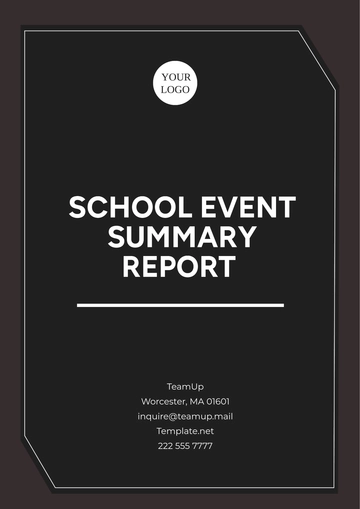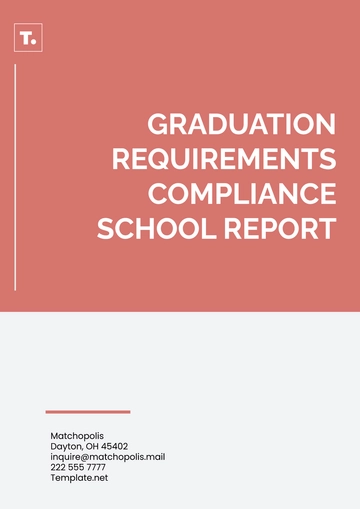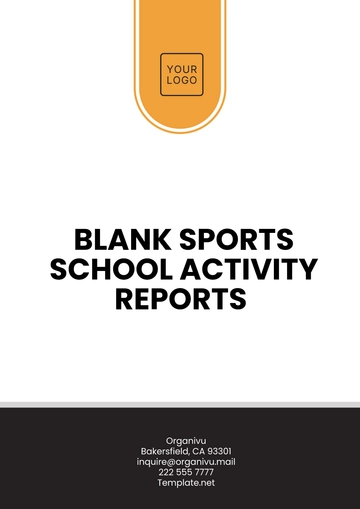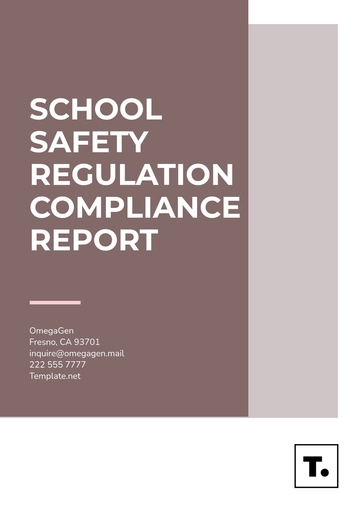Free School Improvement Report

I. Executive Summary
This School Improvement Report outlines the significant progress and strategic initiatives undertaken by [Your Company Name] to enhance educational outcomes and overall school performance. Key findings indicate marked improvements in student achievement, with standardized test scores increasing by [10]% over the past year. Notable achievements include the successful implementation of a new literacy program and the expansion of extracurricular activities, contributing to higher student engagement and attendance rates. The school's investment in professional development for teachers has also yielded positive results, reflected in improved classroom practices and student feedback.
Looking ahead, our primary goals focus on further elevating academic standards, integrating technology into the curriculum, and fostering a more inclusive school environment. Future initiatives include the introduction of a STEM curriculum, the launch of a mental health support program, and enhanced parent-teacher collaboration frameworks. By addressing these areas, [Your Company Name] aims to create a supportive and challenging educational environment that prepares students for success in higher education and beyond. This report serves as a roadmap for continuous improvement, ensuring that the school remains responsive to the evolving needs of its students and community.
II. Introduction
The purpose of this School Improvement Report is to provide a comprehensive overview of the initiatives and strategies implemented by [Your Company Name] to enhance the quality of education and overall performance of the school. This report aims to inform stakeholders—including school administrators, teachers, parents, and educational authorities—about the progress made over the past year, the challenges encountered, and the future plans for continued improvement. The scope of the report covers all key aspects of school functioning, including academic performance, student engagement, staff development, and community involvement.
To ensure a thorough and accurate assessment, a mixed-methods approach was employed for data collection and analysis. Quantitative data were gathered from standardized test scores, attendance records, and behavioral reports, providing measurable indicators of student achievement and school performance. Qualitative data were collected through surveys, focus group discussions, and interviews with students, teachers, parents, and other stakeholders. This allowed for a deeper understanding of the experiences and perceptions of the school community, highlighting areas of strength and identifying opportunities for improvement. Data were analyzed using both statistical methods and thematic analysis to provide a comprehensive view of the school's current state and progress.
[Your Company Name] serves a diverse student population with varying needs and backgrounds. The school is committed to providing a high-quality education that is inclusive and equitable for all students. Over the past few years, the school has undertaken several initiatives to address the academic and social-emotional needs of its students. These include the implementation of targeted intervention programs, the adoption of new instructional technologies, and the enhancement of professional development opportunities for teachers. The school's efforts are guided by its mission to foster a supportive and challenging learning environment where all students can achieve their full potential.
This report is structured to provide a clear and detailed account of the school’s improvement journey. It begins with an executive summary, followed by sections on the school's profile, assessment and analysis, improvement objectives and goals, strategies and action plans, progress monitoring and evaluation, and stakeholder engagement and communication. Through this structured approach, the report aims to present a holistic view of the school’s efforts and achievements, offering insights and recommendations for ongoing and future improvement initiatives.
III. School Profile
[Your Company Name] is a vibrant and diverse educational institution dedicated to providing high-quality education to its students. Located in a thriving community, the school serves a student population of approximately [1,200] students from kindergarten through 12th grade. Our students come from a wide range of cultural and socioeconomic backgrounds, reflecting the rich diversity of the community we serve.
Demographics: The student body at [Your Company Name] is composed of [45]% Hispanic, [30% African American], [15% Caucasian], [7% Asian], and [3]% from other ethnic backgrounds. Approximately [60]% of our students are eligible for free or reduced-price lunch, highlighting the economic diversity within our school community. Our commitment to inclusivity is evident in our efforts to provide tailored support and resources to meet the diverse needs of our students.
Academic Programs: [Your Company Name] offers a comprehensive curriculum designed to cater to the varied interests and abilities of our students. Our academic programs include advanced placement (AP) courses, honors classes, and a robust special education program. Additionally, we offer a wide range of elective courses in the arts, technology, and vocational training. The school is also proud of its bilingual education program, which supports English language learners in achieving academic success while maintaining their native language proficiency.
Staff: Our dedicated staff includes [80] full-time teachers, [15] part-time instructors, and a support team of [20] administrative and ancillary staff members. All our teachers are highly qualified, with [85]% holding advanced degrees and [95]% possessing more than five years of teaching experience. Professional development is a cornerstone of our staff culture, ensuring that our educators are equipped with the latest instructional strategies and best practices.
Resources: [Your Company Name] is well-equipped with modern facilities and resources to support student learning. Our campus features state-of-the-art classrooms, science laboratories, a library media center, and extensive athletic facilities. We have also integrated technology into our classrooms, with each student having access to a personal laptop or tablet. Additionally, the school provides various support services, including counseling, tutoring, and after-school programs, to help students thrive academically and personally.
Through these comprehensive programs and resources, [Your Company Name] is committed to fostering a nurturing and challenging environment where every student can excel.
IV. Assessment and Analysis
To offer a clear and comprehensive evaluation of [Your Company Name]'s current state, this section delves into various critical metrics including student performance, attendance, and behavior. Utilizing both quantitative and qualitative data, we provide a detailed analysis that highlights key trends and areas for improvement. Additionally, a SWOT analysis is presented to identify the school's strengths, weaknesses, opportunities, and threats, offering a strategic overview to guide future initiatives. The following table consolidates these insights, providing a snapshot of the school’s current performance and strategic position.
Student Performance
This table provides a snapshot of [Your Company Name]'s student performance metrics, including average math and reading scores, AP participation and pass rates, and state proficiency standards. These metrics offer insights into the academic achievements of our students and the effectiveness of our educational programs.
Metric | Data |
|---|---|
Average Math Score | Increased by 10% |
Average Reading Score | Increased by 8% |
AP Participation Rate | 60% of eligible students |
AP Exam Pass Rate | 75% |
State Proficiency Standards | 85% of students meet or exceed |
Attendance
The Attendance table highlights [Your Company Name]'s attendance rates, including overall attendance and chronic absenteeism. These metrics are crucial indicators of student engagement and school climate, reflecting the effectiveness of our strategies to promote regular attendance and reduce absenteeism.
Metric | Data |
|---|---|
Overall Attendance Rate | 94% |
Chronic Absenteeism | Decreased by 5% |
Behavior
The Behavior table showcases [Your Company Name]'s disciplinary metrics, including reductions in suspensions and expulsions. These metrics reflect the effectiveness of our behavior management strategies and programs, indicating improvements in student behavior and school safety.
Metric | Data |
|---|---|
Reduction in Suspensions | 20% decrease |
Reduction in Expulsions | 20% decrease |
SWOT Analysis
The SWOT Analysis table presents a strategic overview of [Your Company Name]'s strengths, weaknesses, opportunities, and threats. This analysis provides a holistic view of the internal and external factors influencing our school, guiding us in leveraging strengths, addressing weaknesses, pursuing opportunities, and mitigating threats for continuous improvement.
Strengths | Weaknesses |
|---|---|
|
|
Opportunities | Threats |
|---|---|
|
|
V. Improvement Objectives and Goals
[Your Company Name] has set forth specific objectives and goals aimed at enhancing the overall quality of education and student outcomes. These goals are aligned with district, state, and national educational standards to ensure comprehensive and cohesive improvement efforts.
Objective | Goal | Strategies | Alignment |
|---|---|---|---|
Increase Academic Achievement | Improve student performance in math and reading by 10% over the next three years. | Implement data-driven instructional practices, provide targeted interventions for struggling students, and expand professional development for teachers. | Aligns with state proficiency standards and district academic performance targets. |
Enhance STEM Education | Develop and implement a comprehensive STEM program to increase student participation and proficiency. | Introduce new STEM courses, establish partnerships with local STEM organizations, and provide professional development for teachers in STEM education. | Supports national priorities to promote STEM education. |
Reduce Achievement Gaps | Decrease achievement gaps among different student demographics by 15% within the next five years. | Implement culturally responsive teaching practices, provide additional resources for underperforming students, and engage families in the educational process. | Aligns with district equity initiatives and state mandates for closing achievement gaps. |
Improve Attendance Rates | Increase overall attendance rate to 96% and reduce chronic absenteeism by 10% over the next two years. | Develop personalized attendance plans, enhance communication with parents, and provide incentives for regular attendance. | Supports state and district attendance improvement initiatives. |
Foster a Positive School Climate | Reduce disciplinary incidents by 20% and increase student satisfaction with the school environment. | Implement social-emotional learning (SEL) programs, provide professional development for teachers in behavior management, and create a positive behavior reinforcement system. | Aligns with national standards for safe and supportive school environments. |
VI. Strategies and Action Plans
To ensure the effective implementation of our improvement objectives, we have developed detailed strategies and action plans. Each plan outlines specific actions, timelines, responsible parties, and resource allocations necessary to achieve our goals. By emphasizing evidence-based practices and interventions, we aim to drive meaningful improvements in student outcomes. The following table consolidates these strategies and action plans, providing a clear roadmap for our initiatives and ensuring accountability and resource management throughout the implementation process.
Increase Academic Achievement
Strategy | Actions | Timeline | Responsible Parties | Resource Allocation |
|---|---|---|---|---|
Data-driven instructional practices | Train teachers in data analysis, implement data tracking systems, review student data monthly. | Year 1, ongoing | Academic Coordinator, Teachers | $10,000 for training and software |
Targeted interventions | Identify struggling students, develop individualized support plans, monitor progress bi-weekly. | Year 1, ongoing | Special Education Team, Tutors | $15,000 for tutoring resources |
Professional development for teachers | Conduct workshops on effective teaching methods, provide ongoing coaching and feedback. | Year 1, ongoing | Professional Development Coordinator | $8,000 for workshops and materials |
Enhance STEM Education
Strategy | Actions | Timeline | Responsible Parties | Resource Allocation |
|---|---|---|---|---|
New STEM courses | Design and introduce new STEM curriculum, purchase necessary materials, hire specialized instructors. | Year 2 | Curriculum Director, STEM Teachers | $25,000 for materials and salaries |
Partnerships with local STEM organizations | Establish partnerships, organize field trips, arrange guest lectures from industry experts. | Year 2 | Community Liaison, STEM Coordinator | $5,000 for partnership activities |
Professional development in STEM education | Provide training for teachers in latest STEM teaching methods and technologies. | Year 2 | Professional Development Coordinator | $7,000 for training programs |
Reduce Achievement Gaps
Strategy | Actions | Timeline | Responsible Parties | Resource Allocation |
|---|---|---|---|---|
Culturally responsive teaching practices | Train teachers in culturally responsive pedagogy, incorporate diverse perspectives in curriculum. | Year 3 | Diversity and Inclusion Officer, Teachers | $12,000 for training and materials |
Additional resources for underperforming students | Allocate additional support staff, provide extra tutoring sessions, supply learning materials. | Year 3 | Academic Support Team, Tutors | $20,000 for support staff and materials |
Family engagement initiatives | Organize family workshops, improve communication channels, develop family-school partnership programs. | Year 3 | Family Engagement Coordinator | $10,000 for workshops and materials |
VII. Progress Monitoring and Evaluation
To ensure that our improvement goals are being met effectively, [Your Company Name] has established a comprehensive system for monitoring progress and evaluating outcomes. This section outlines the mechanisms for tracking progress, including benchmarks, performance indicators, and evaluation methods. Additionally, it provides a schedule for regular review and updates to our improvement strategies.
Mechanisms for Monitoring Progress
Benchmarks: Establish specific milestones and targets for each improvement goal.
Performance Indicators: Use measurable data points such as test scores, attendance rates, and disciplinary incidents to track progress.
Evaluation Methods: Utilize qualitative and quantitative methods to assess the effectiveness of strategies and actions.
Schedule for Review: Conduct regular reviews of progress against benchmarks and adjust strategies as needed.
Schedule for Review and Updates
Quarterly reviews to assess progress and make adjustments.
Annual evaluations to measure overall progress towards improvement goals.
Continuous monitoring of key performance indicators to identify trends and areas needing improvement.
Reporting and Communication
Regular reports to stakeholders, including staff, parents, and the community, to communicate progress and outcomes.
Utilize data visualization tools and presentations to effectively communicate progress and outcomes.
VIII. Stakeholder Engagement and Communication
[Your Company Name] recognizes the importance of engaging stakeholders in the improvement process to ensure its success. This section outlines our approach to involving students, parents, teachers, and community members in our improvement efforts, as well as our communication strategies to keep stakeholders informed and engaged.
Engagement of Stakeholders
Students: Encourage student participation in school improvement through surveys, focus groups, and student advisory committees.
Parents: Involve parents through regular meetings, newsletters, and parent-teacher conferences to keep them informed about school improvement initiatives and seek their input.
Teachers: Engage teachers in the improvement process through professional development opportunities, feedback sessions, and collaboration on action plans.
Community Members: Partner with community organizations, businesses, and local leaders to garner support for school improvement efforts and involve them in relevant projects or initiatives.
Communication Strategies
Regular Updates: Provide regular updates on progress towards improvement goals through newsletters, emails, and social media.
Meetings and Forums: Organize meetings and forums to discuss improvement efforts and gather feedback from stakeholders.
Website and Online Platforms: Maintain a dedicated section on the school website and utilize online platforms for sharing information and updates.
Feedback Mechanisms: Establish feedback mechanisms such as suggestion boxes, surveys, and open forums to gather input from stakeholders.
Collaborative Efforts: Encourage collaborative efforts among stakeholders by involving them in decision-making processes and seeking their input on improvement strategies.
Collaborative Efforts
Parent-Teacher Collaboration: Foster collaboration between parents and teachers to support student learning and achievement.
Community Partnerships: Collaborate with community partners to provide additional resources and opportunities for students.
Student Involvement: Empower students to take an active role in the improvement process and encourage their participation in decision-making.
By engaging stakeholders and implementing effective communication strategies, [Your Company Name] aims to create a collaborative and inclusive environment that supports continuous improvement and enhances the overall educational experience for all stakeholders.
- 100% Customizable, free editor
- Access 1 Million+ Templates, photo’s & graphics
- Download or share as a template
- Click and replace photos, graphics, text, backgrounds
- Resize, crop, AI write & more
- Access advanced editor
Enhance school performance with the School Improvement Report Template from Template.net. This editable and customizable template helps you draft comprehensive and professional improvement reports. Editable in our Ai Editor Tool, it offers a user-friendly experience, making it easy to tailor to your school's specific needs. Drive positive changes with this essential improvement report template.
You may also like
- Sales Report
- Daily Report
- Project Report
- Business Report
- Weekly Report
- Incident Report
- Annual Report
- Report Layout
- Report Design
- Progress Report
- Marketing Report
- Company Report
- Monthly Report
- Audit Report
- Status Report
- School Report
- Reports Hr
- Management Report
- Project Status Report
- Handover Report
- Health And Safety Report
- Restaurant Report
- Construction Report
- Research Report
- Evaluation Report
- Investigation Report
- Employee Report
- Advertising Report
- Weekly Status Report
- Project Management Report
- Finance Report
- Service Report
- Technical Report
- Meeting Report
- Quarterly Report
- Inspection Report
- Medical Report
- Test Report
- Summary Report
- Inventory Report
- Valuation Report
- Operations Report
- Payroll Report
- Training Report
- Job Report
- Case Report
- Performance Report
- Board Report
- Internal Audit Report
- Student Report
- Monthly Management Report
- Small Business Report
- Accident Report
- Call Center Report
- Activity Report
- IT and Software Report
- Internship Report
- Visit Report
- Product Report
- Book Report
- Property Report
- Recruitment Report
- University Report
- Event Report
- SEO Report
- Conference Report
- Narrative Report
- Nursing Home Report
- Preschool Report
- Call Report
- Customer Report
- Employee Incident Report
- Accomplishment Report
- Social Media Report
- Work From Home Report
- Security Report
- Damage Report
- Quality Report
- Internal Report
- Nurse Report
- Real Estate Report
- Hotel Report
- Equipment Report
- Credit Report
- Field Report
- Non Profit Report
- Maintenance Report
- News Report
- Survey Report
- Executive Report
- Law Firm Report
- Advertising Agency Report
- Interior Design Report
- Travel Agency Report
- Stock Report
- Salon Report
- Bug Report
- Workplace Report
- Action Report
- Investor Report
- Cleaning Services Report
- Consulting Report
- Freelancer Report
- Site Visit Report
- Trip Report
- Classroom Observation Report
- Vehicle Report
- Final Report
- Software Report





























